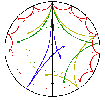Jet Stream Runs Swiftly Inside the Sun
Background and Related Information
The following may provide additional information useful in understanding and describing these results.
Images | Papers and Publications | Helioseismology | Educational Resource
Images
The difference between observed and model sound speed as a function of depth in the Sun. The "bump" just below 0.7 R indicates the possible location of excess turbulence.
| Full -sized Image (500Kb) | Postscript File |
The inferred rotation rate is shown as a function of depth and latitude. The convection zone evidently rotates uniformly along a radius with all depths showing the differential rotation seen at the surface. Underneath the convection zone is a layer of shear below which the radiative interior seems to rotate rigidly. This shear zone which coincides with the sound speed excess could be the region where the solar cycle dynamo operates.
| Full -sized Image (500Kb) | Postscript File | This dramatic graphic shows the radial and latitudinal variations of the sound speed in the Sun, relative to a standard solar model. Red color corresponds to the positive variations (`hotter' regions), and blue color corresponds to negative variations (`cooler' regions).
Sound speed description and image | Image only (200Kb)
Dopplergram (500Kb)
Because the Sun rotates, one side is coming toward us at 2 km/s and the other is going away. The figure is a map of the speed of the Sun's surface as measured by the SOHO/MDI instrument; the colors indicate motion toward us (dark) or away (lighter). Superimposed on the dominant left-right rotational gradient, you can see smaller scale features. These features are caused by solar phenomena including supergranulation, granulation, and p modes. The small bright feature right of center was caused by an active region where the magnetic field at the surface was very strong. MDI measures the velocity and brightness at nearly a million points on the Sun's surface every minute.
The Sun resonates like a huge musical instrument. However, unlike a musical instrument that is tuned to a single frequency, the Sun resonates in tens of millions of ways all at the same time. The figure shows how much acoustic energy there is at each frequency for every one of the spatial modes of solar oscillation. The pitch of the resonance depends on the physical conditions in the interior of the Sun where the sound waves travel. So, the frequency of each mode reveals something about a slightly different part of the Sun's interior.
L-nu description and medium-sized image | Large l-nu image only (500Kb) Acoustic waves may be trapped in a region bounded on top by a large drop in density near the surface, and on the bottom by an increase in sound speed that refracts a downward propagating wave back toward the surface.
P modes are oscillations of the whole Sun. The images show what happens when groups of oscillations begin to interrelate with each other and set up stable patterns.
- P-mode Description and Images
- P-mode Shapes -- Images Only (200Kb)
- P-mode Shapes -- Images Only (PostScript)
Papers, Publications:
- Solar Rotation and Large-Scale Flows Determined by Time-Distance Helioseismology from SOHO/MDI (Abstract)
- Heliospheric Constraints on the Structure of the Solar Tachocline (PostScript)
- Structure and Rotation of the Solar Interior: Initial Results from the MDI Medium-l Program Solar Physics, 1997, in press. (PostScript)
Helioseismology Explanations
- Helioseismology Introduction (SOI - Stanford)
- Helioseismology Overview (GONG)
- Helio- and Asteroseismology (Aarhus University)
- Helioseismology Bibliography (SOI - Stanford)
Educational Resource:
The Stanford SOLAR Center -- our Educational web site providing on-line activities to encourage and share the wonder of solar science exploration.
This page is http://soi.stanford.edu/press/ssu8-97/background.html
Last Updated: 14 September 1997



